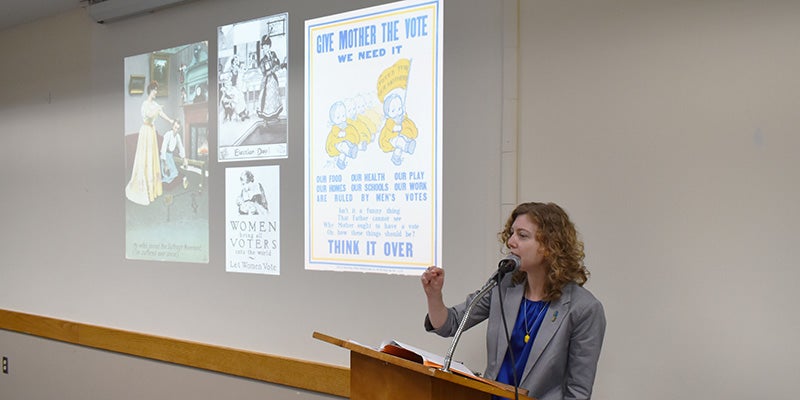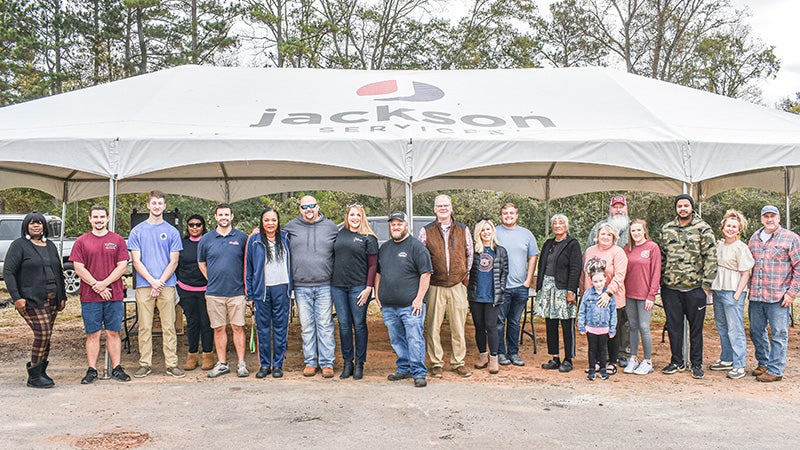Women’s Suffrage movement: A look back at Chambers County
Published 9:00 am Tuesday, March 21, 2023
|
Getting your Trinity Audio player ready...
|
VALLEY — March is recognized as Women’s History Month, and as a special event during the month, Cobb archivist Robin Watson recently presented a program at Bradshaw-Chambers County Library on the Women’s Suffrage movement. Women in the U.S. did not have the right to vote until the 19th Amendment to the U.S. Constitution was approved in 1920. Tennessee was the final state to provide the three-fourths margin needed to approve it. Alabama was very late to backing it. The State Legislature got around to doing it in 1953, some thirty-three years after it was the law of the land.
Some American colonies had allowed women the right to vote in the 1700s. A movement to permit it nationally got under way in earnest by the middle of the nineteenth century. Several generations of women supporting this basic right lectured, wrote, marched, lobbied and practiced civil disobedience to achieve what many Americans considered a radical change to the U.S. Constitution.
Black men had gotten that right with the passage of the 15th Amendment in the years following the Civil War. But just like white women, black women could not vote until the 19th Amendment was adopted.
“Women’s suffrage sparked intense feelings on both sides of the issue,” Watson said.
She illustrated that point by showing posters from the period advocating both sides of the issue. Two of the posters were pro suffrage, underscoring the point that it was their right as an adult. The anti-suffrage posters made the point that a woman’s role was to be a wife and mother.
Watson noted four principal leaders of the women’s suffrage movement. They included Susan B. Anthony (1820-1906), Elizabeth Cady Stanton (1815-1902), Carrie Chapman Catt (1885-1947) and Alice Paul (1885-1977).
“Stanton was the intellectual leader of the movement and Anthony the organizer and figurehead,” Watson said. “Though neither one lived to see the 19th Amendment ratified in 1920, they paved the way for passage. “
The amendment was frequently called the Susan B. Anthony amendment.
Carrie Chapman Catt was Anthony’s handpicked successor. She was president of the Women’s Suffrage Association in the year the 19th Amendment became part of the U.S. Constitution.
Alice Paul was the member of a prosperous and progressive Quaker family. She was well educated, having earned a Ph.D. in 1910. A supporter of women’s suffrage, Paul traveled to England where she encountered a militant suffrage movement. Women’s groups would picket and take part in hunger strikes.
When Paul returned to the U.S. she would lead such protests in the U.S. She even had some picketing outside the White House during Woodrow Wilson’s presidency. Paul wasn’t only a supporter of a woman’s right to vote, she also supported and Equal Rights Amendment, something that has yet to be added to the Constitution.
Watson said that Selma and Birmingham were the hotbeds for women’s suffrage in Alabama. The leaders of those movements were Patti Ruffler Jacobs and Bossie O’Brien Hundley.
“In Selma, professional women and club women rallied around suffrage,” Watson said. “They were also interested in programs and policies concerned with public health and safety. “
Suffrage societies in Selma and Birmingham combined to form the Alabama Equal Suffrage Association in 1912. Led by capable and energetic women such as Jacobs and Hundley, the AESA traveled the state rallying like-minded men and women to organize for suffrage.
“Their travels took them to Chambers County, on the far eastern end of the state and on the cusp of modernity,” said Watson. “Automobiles were beginning to appear, and a push for good roads soon followed. These good roads led straight to the Chambers County courthouse, where Bossie O’Brien Hundley made her case for women’s suffrage.”
An account of that May 1914 meeting ran in the Birmingham News. A total of 25 people were there. Hundley called this meeting the trip’s “Crowning Glory” because it was taking place “on the very hearthstone of that arch enemy of suffrage, J. Thomas Heflin.”
“No one was louder in opposition to suffrage than Tom Heflin,” Watson said. “In a lecture in Lanett, he decried suffrage as a ‘twin evil’ up there with socialism.”
Heflin was a leader of the anti-suffrage movement and was invited to speak in many venues. In a speech in Lynchburg, Virginia in 1913, Heflin said that women’s suffrage would destroy harmonious relations between men and women. “Antagonisms will spring up in its place,” he said. “The American home is doomed, and the American republic is dead. The women’s suffrage movement is the greatest peril now threatening the English speaking people. In the name of gentle, home-loving women of America, I call upon you to fight this dangerous deadly movement and save the life of this nation.”
Born in Randolph County in 1869, Heflin studied at Birmingham Southern and Auburn before studying law under a Mr. Denson in LaFayette. He passed the bar exam and practiced law in LaFayette. He became mayor of the town in 1893 and became a member of the state legislature., where he remained until 1900. He was a delegate to the State Constitutional Convention in 1901 and served as Alabama secretary of state from 1902 to 1904. He resigned that position to become a member of the U.S. House of Representatives, where he would serve for 16 years. He is credited with introducing legislation establishing Mother’s Day in the U.S. and encouraging fellow Americans to wear white carnations on that day.
Supporters of women’s suffrage saw no conflict between Heflin’s traditional view of motherhood and women having the right to vote. “Why can’t they be citizens, too?” they responded.
Even so, Heflin took his views and oratorical skills all over the state, claiming that half of the suffragists were divorced with the other half being the products of unhappy homes.
Tired of such talk, Bossie O’Brien Hundley challenged him to a debate. Heflin refused. He sent word to her he would gladly debate any other man in the legislature but would not be debating a woman.
Heflin went on to bash supporters of women suffrage as female fanatics, and “woodenheaded suffro-tescents” (whatever that means).
“What of Chambers County suffragists?” Watson asked. “Were these women divorced of the products of unhappy homes? I doubt it.”
Many of them were college-educated school teachers.
The president of the 25-member LaFayette Equal Suffrage Association was Mary Andrews. She headed a very active chapter which sought a woman’s right to vote in Alabama. Andrews hosted suffrage meetings in her home and was a study club member with Heflin’s wife, Minnie Kate. “I wonder how Heflin’s criticisms sat with Mary Andrews?” Watson said. “In light of her own life and character, she may have wondered how he could make such remarkable statements.”
World War I interrupted the drive for women’s suffrage. As men joined the war effort, women stepped up to do their part in defending democracy.
In 1917, LaFayette City Schools hired a new superintendent, Edward McGehee.
Watson said that he was superbly qualified, having taught at Columbia earlier that year. “He brought his wife Thomasine with him to LaFayette,” Watson said. “This dynamic woman would leave a lasting imprint on the town.”
She had studied in New York in what is now the Juliard School. “Doubtless LaFayette was a far cry from New York City but was likely more the pace they were accustomed to,” Watson said.
Edward had been raised in a small town in Virginia and Thomasine in Corsicana, Texas.
The McGehees were active in the Red Cross movement in the local area. This was one way they could help the war effort. Women throughout Chambers County served in War Service Centers, where they rolled bandages and corresponded with local soldiers who were far away from home. They also grew victory gardens and contributed to the Liberty Loans program and purchased War Savings Stamps.
Thomasine had a personal connection to the war. Her brother Cobb was in the Army and served in France.
Mary Andrews had several brothers who served in the war. One of them, John Andrews, served in the famed Rainbow Division and was being treated for having been gassed when the war ended.
The experience these women had in the Red Cross was helpful on that Sunday in March 1920 when parts of east Alabama and West Point had a tornado outbreak. Many people were hurt or killed as an EF-4 tornado cut a path from Elmore County and across Tallapoosa and Chambers counties before devastating West Point.
In the post-war years, a mutual friendship between Mary Andrews and Thomasine McGehee helped revitalize the local suffrage movement. Meetings of the Chambers County Equal Suffrage Association took place in the Andrews family home in LaFayette. Ironically, the home had formerly been the home of Lewis and Mary Schuessler, the grandparents of Tom Heflin’s wife, Minnie Kate.
In addition to Mary Andrews and Thomasine McGehee, other members of the organization included Ruth Allen, Mrs. Sue Pate, Mrs. Rea Schuessler, Mrs. Q.P. Siler, Mrs. George Hollingsworth, Mrs. Dorsey Tatum, Mrs. W.M. Sellers, Mrs. N.E. Baker, Miss Susie May Smith and Miss Frances Andrews. Many of them were local teachers and active in a local church.
The LaFayette club was not Alabama’s largest organization to support the a woman’s right to vote abut was considered by state leaders the crowning glory of the movement in Alabama. Having any active organization in Tom Heflin’s hometown was considered a big, big thing at the time.




